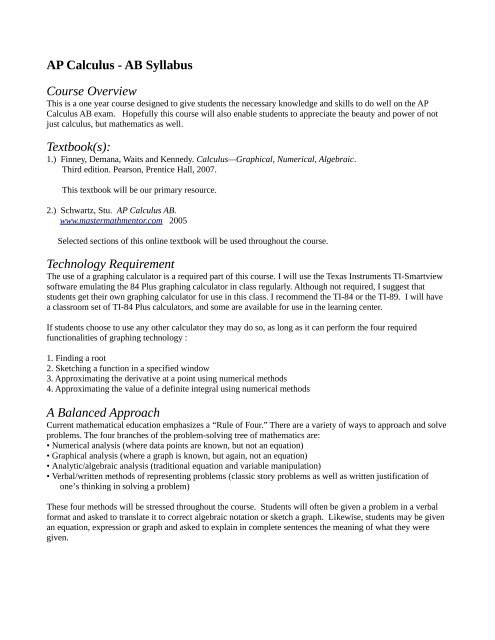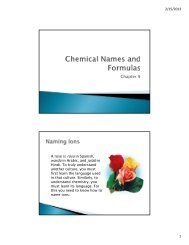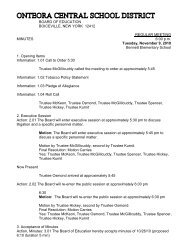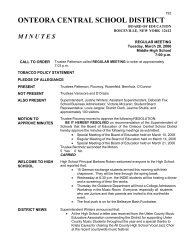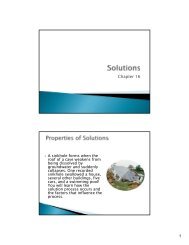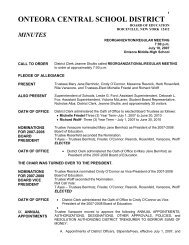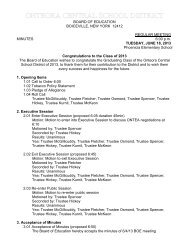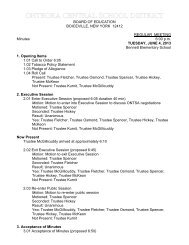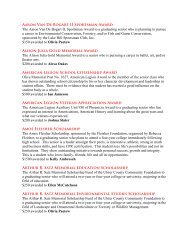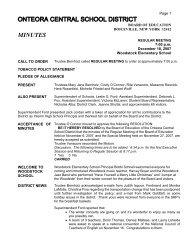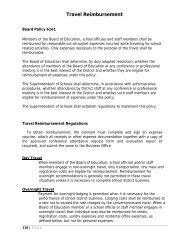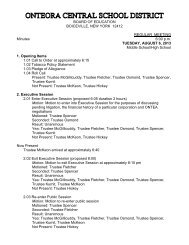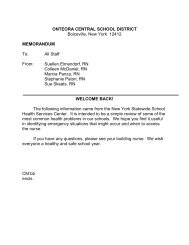AP Calculus - AB Syllabus Course Overview Textbook(s ...
AP Calculus - AB Syllabus Course Overview Textbook(s ...
AP Calculus - AB Syllabus Course Overview Textbook(s ...
You also want an ePaper? Increase the reach of your titles
YUMPU automatically turns print PDFs into web optimized ePapers that Google loves.
<strong>AP</strong> <strong>Calculus</strong> - <strong>AB</strong> <strong>Syllabus</strong><strong>Course</strong> <strong>Overview</strong>This is a one year course designed to give students the necessary knowledge and skills to do well on the <strong>AP</strong><strong>Calculus</strong> <strong>AB</strong> exam. Hopefully this course will also enable students to appreciate the beauty and power of notjust calculus, but mathematics as well.<strong>Textbook</strong>(s):1.) Finney, Demana, Waits and Kennedy. <strong>Calculus</strong>—Graphical, Numerical, Algebraic.Third edition. Pearson, Prentice Hall, 2007.This textbook will be our primary resource.2.) Schwartz, Stu. <strong>AP</strong> <strong>Calculus</strong> <strong>AB</strong>.www.mastermathmentor.com 2005Selected sections of this online textbook will be used throughout the course.Technology RequirementThe use of a graphing calculator is a required part of this course. I will use the Texas Instruments TI-Smartviewsoftware emulating the 84 Plus graphing calculator in class regularly. Although not required, I suggest thatstudents get their own graphing calculator for use in this class. I recommend the TI-84 or the TI-89. I will havea classroom set of TI-84 Plus calculators, and some are available for use in the learning center.If students choose to use any other calculator they may do so, as long as it can perform the four requiredfunctionalities of graphing technology :1. Finding a root2. Sketching a function in a specified window3. Approximating the derivative at a point using numerical methods4. Approximating the value of a definite integral using numerical methodsA Balanced ApproachCurrent mathematical education emphasizes a “Rule of Four.” There are a variety of ways to approach and solveproblems. The four branches of the problem-solving tree of mathematics are:• Numerical analysis (where data points are known, but not an equation)• Graphical analysis (where a graph is known, but again, not an equation)• Analytic/algebraic analysis (traditional equation and variable manipulation)• Verbal/written methods of representing problems (classic story problems as well as written justification ofone’s thinking in solving a problem)These four methods will be stressed throughout the course. Students will often be given a problem in a verbalformat and asked to translate it to correct algebraic notation or sketch a graph. Likewise, students may be givenan equation, expression or graph and asked to explain in complete sentences the meaning of what they weregiven.
<strong>Course</strong> OutlineIntroduction to <strong>Calculus</strong> (1 week)A. An intuitive approach to calculus will be developed using the classic motion problemviewed from several approaches.1. Finding speed from the position (the derivative)2. Finding distanced traveled from the speed (the integral)3. Understanding the relationship between the two processes (Fundamental Theorem of<strong>Calculus</strong>)Unit 1: Limits and Continuity (3 - 4 weeks)A. Rates of Change1. Average Speed2. Instantaneous SpeedBefore beginning a formal look at limits, students will develop an intuitive sense of limits by exploringdiscontinuities and asymptotes of functions using the graphing calculator. Students will use the zoomfeature or tables of values to verbally explain the behavior of the graph as it approaches certain points.B. Limits at a Point1. 1-sided Limits2. 2-sided Limits3. Sandwich TheoremC. Limits involving infinity1. Asymptotic behavior (horizontal and vertical)2. End behavior models3. Properties of limits (algebraic analysis)4. Visualizing limits (graphic analysis)D. Continuity1. Continuity at a point2. Continuous functions3. Discontinuous functionsa. Removable discontinuity (0/0 form)b. Jump discontinuity (We look at y = int(x).)c. Infinite discontinuityE. Rates of Change and Tangent Lines1. Average rate of change2. Tangent line to a curve3. Slope of a curve (algebraically and graphically)4. Normal line to a curve (algebraically and graphically)5. Instantaneous rate of changeUnit 2: The Derivative (5 - 6 weeks)A. Derivative of a Function1. Definition of the derivative (difference quotient)2. Derivative at a Point3. Relationships between the graphs of f and f’4. Graphing a derivative from data
5. One-sided derivativesB. Differentiability1. Cases where f’(x) might fail to exist2. Local linearity3. Derivatives on the calculator (Numerical derivatives using NDERIV)4. Symmetric difference quotient5. Relationship between differentiability and continuity6. Intermediate Value Theorem for DerivativesC. Rules for Differentiation1. Constant, Power, Sum, Difference, Product, Quotient Rules2. Higher order derivativesD. Derivatives of trigonometric functionsE. Chain RuleF. Implicit Differentiation1. Differential method2. y’ methodG. Derivatives of inverse trigonometric functionsH. Derivatives of Exponential and Logarithmic FunctionsUnit 3: Applications of the Derivative (5 - 6 weeks)A. Extreme Values1. Relative Extrema2. Absolute Extrema3. Extreme Value Theorem4. Definition of a critical pointB. Implications of the Derivative1. Rolle’s Theorem2. Mean Value Theorem3. Increasing and decreasing functionsC. Connecting f’ and f’’ with the graph of f(x)1. First derivative test for relative max/min2. Second derivativea. Concavityb. Inflection pointsc. Second derivative test for relative max/minD. Optimization problemsE. Linearization models – We will be begin this section with a discussion of how students use locallinearization every day (i.e. What does it mean to walk a straight line?)Students will then explore theconcept of local linearization by graphing fuctions on a calculator and zooming in until the curve
"straightens out". They will then be asked to explain the significance of this.1. Local linearization2. Tangent line approximation3. DifferentialsF. Particle motion, Position, velocity, acceleration, and jerk. We will explore this concept using a CBL(Calculator Based Labratory) attached to a graphing calculator, and have the students be the particle.G. Economics1. Marginal cost2. Marginal revenue3. Marginal profitH. Related RatesMIDTERM EXAMUnit 4: The Definite Integral (3–4 weeks)A. Approximating areas – Students will a Riemann Sums program on the calculator to visualize exactlywhat a Riemann sum is. The will then be asked to explain the differences between the four types.1. Riemann sumsa. Left sumsb. Right sumsc. Midpoint sumsd. Trapezoidal sums2. Definite integralsB. Properties of Definite Integrals1. Power rule2. Mean value theorem for definite integralsC. The Fundamental Theorem of <strong>Calculus</strong>1. Part 12. Part 2Unit 5: Differential Equations and Mathematical Modeling (4 weeks)A. Slope FieldsB. Antiderivatives1. Indefinite integrals2. Power formulas3. Trigonometric formulas4. Exponential and Logarithmic formulasC. Separable Differential Equations1. Growth and decay2. Slope fields (Resources from the <strong>AP</strong> <strong>Calculus</strong> website will be liberally used.)3. General differential equations4. Newton’s law of coolingD. Logistic Growth
Unit 6: Applications of Definite Integrals (3 weeks)A. Integral as net change1. Calculating distance traveled (particle motion)2. Consumption over time3. Net change from dataB. Area between curves1. Area between a curve and an axisa. Integrating with respect to xb. Integrating with respect to y2. Area between intersecting curvesa. Integrating with respect to xb. Integrating with respect to yC. Calculating volume1. Cross sections2. Disc method3. Shell methodUnit 7: Review/Test Preparation (Approximately 2– 4weeks)A. Multiple-choice practice (Items from past exams—1997, 1998, and 2003are used as well as items from review books.)1. Test taking strategies are emphasized2. Individual and group practice are both usedB. Free-response practice (Released items from the <strong>AP</strong> Central website are used liberally.)1. Rubrics are reviewed so students see the need for complete answers, written in full sentences.2. Students collaborate to formulate team responses3. Individually written responses are crafted. Attention to full explanations is emphasized.Unit 8: After the exam…A. Review of the <strong>AP</strong> exam and try to identify points that students felt confident with or points thatstudents felt they needed more work with. This will help strengthen those points before studentsgo to college, as well as help me adjust the course for next year.B. Students will be required to do and present projects designed to incorporate this year’s learning inapplied ways. Projects can be of the students own choosing with teacher approval or chosen fromone of the following sources.MAA Notes. Resources for <strong>Calculus</strong> Collection. , D.C.: MAA, 1993.Volume 3: Applications of <strong>Calculus</strong>, edited by Philip Straffin. MAA Notes Number 29.Volume 4: Problems for Student Investigation, edited by Michael B. Jackson and John R.Ramsay. MAA Notes Number 30.Volume 5: Readings for <strong>Calculus</strong>, edited by Underwood Dudley. MAA Notes Number 31.
EvaluationStudents will be assigned homework on a daily basis. Each week a cumulative assignment will be giventhat will collected and graded. Homework will count as 30% of the students grade. Once a week ashort quiz will be given. Quizzes will count as 30% of the students grade. Two exams will be giveneach quarter, one after each unit. Tests will count 40% of the students grade. All graded homeworkassignments and exams will include questions where students must explain their answers in completesentences using correct units as well. Students will also be asked to explain the thought process theyused to solve a problem.


